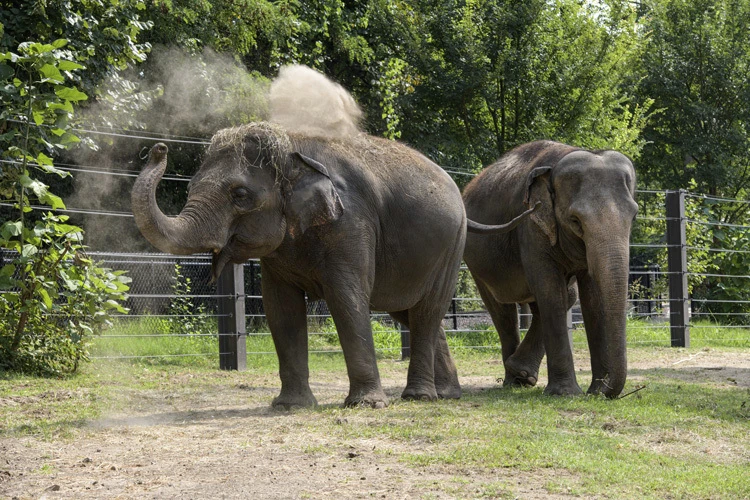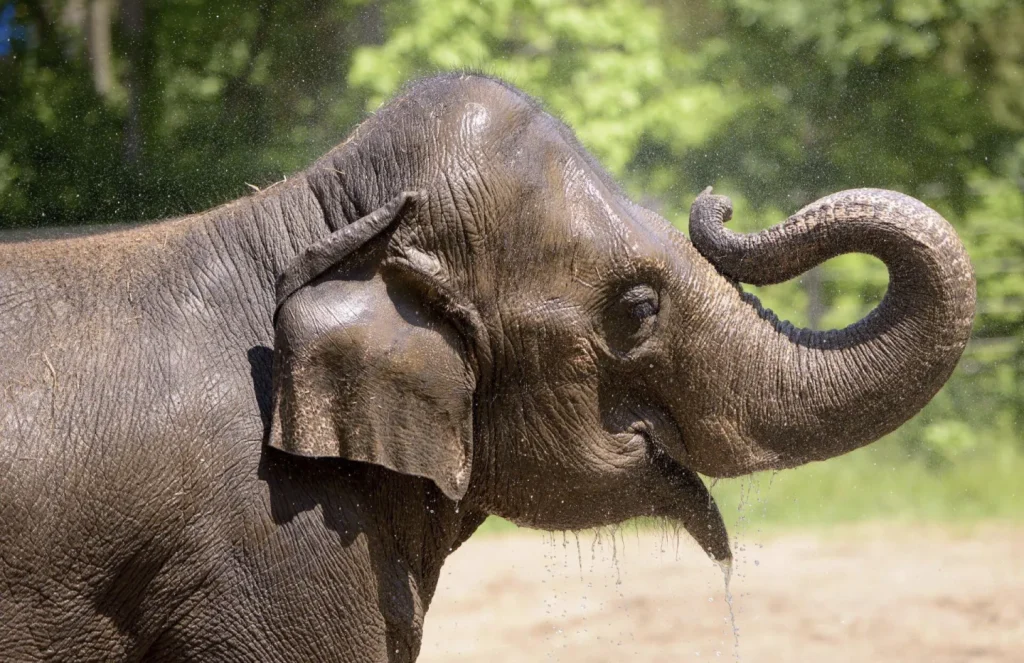The St. Louis Zoo recently experienced a tragic incident that resulted in the untimely death of a female Asian elephant named Rani.
According to zoo officials, the unfortunate event occurred when Rani’s herd became highly agitated due to the presence of a small dog that had managed to run loose within the zoo premises.
Regrettably, Rani, who was 27 years old at the time, succumbed to the distress caused by the chaotic situation and passed away on Friday.
The zoo authorities, still reeling from the loss, made the heartbreaking announcement on Tuesday, expressing their profound sorrow and seeking solace from the community.
In a news release, Zoo Director Michael Macek conveyed their devastation, emphasizing the need for support and thoughts during this difficult period.
Despite the tireless efforts of the zoo’s team of dedicated animal care professionals, Rani’s life could not be saved, leaving a void that will be deeply felt by all who knew and cared for her.
On Friday afternoon, a peculiar incident unfolded at the zoo as a small, unleashed, and seemingly lost dog was spotted running in a non-public area near the Elephant Barn.
The dedicated elephant care workers immediately sprang into action, attempting to contain the dog and ensure its safety.
However, their efforts were met with an unexpected challenge when one of the elephants outside the barn became visibly agitated by the presence of the dog. In order to prevent any potential harm or disturbance, the decision was made to swiftly move the agitated elephant inside the barn.
This incident serves as a testament to the vigilance and quick thinking exhibited by the zoo staff, who prioritize the safety and well-being of both their animal residents and visitors.
Rani, the elephant, had sought solace inside the barn, indulging in her meal, completely unaware of the presence of a dog nearby.
However, it was the keen observation of the dedicated members of the elephant care team that shed light on the peculiar behavior exhibited by Rani.
According to the official statement released by the zoo, the team witnessed Rani becoming increasingly distressed in response to the vocalizations emanating from the rest of the herd.
In a matter of moments, Rani was seen circling around and emitting vocalizations of her own, before succumbing to the overwhelming emotions and collapsing.
This series of events unfolded within a remarkably short span of time, leaving the team perplexed and concerned for Rani’s well-being.
In the wake of recent events, it has been reported that attempts to revive the elephant that had collapsed in the zoo were unsuccessful.
Despite the best efforts of the zookeepers and medical staff, the animal could not be saved. This unfortunate incident has sent shockwaves through the community, sparking a renewed interest in the welfare of animals in captivity.
While the exact cause of the elephant’s collapse remains unclear, it is believed that it may have been due to a range of factors, including stress, illness, or even mistreatment.
Nevertheless, it is heartening to hear that the rest of the herd calmed down quickly, indicating that the zoo staff were able to handle the situation effectively and prevent any further harm to the animals.
As we continue to reflect on this tragic event, it is important to remember that the well-being of animals in captivity is a matter of great importance, and that we must do everything in our power to ensure that they are treated with care, respect, and dignity.
The preliminary findings from the necropsy conducted on Rani, the beloved resident of our zoo, have revealed the presence of certain preexisting alterations in her heart.
However, it is imperative to note that further investigations are currently underway, and our team of highly skilled zoo pathologists is diligently working to ascertain whether these changes had any influence on her untimely demise.
The complexity of the human cardiovascular system necessitates a comprehensive examination, and only through meticulous analysis can we hope to unravel the intricate details surrounding Rani’s tragic passing.
As such, it is premature to draw any definitive conclusions at this stage, and we eagerly await the results of the additional tests that are being conducted.
The dedicated efforts of our pathologists, combined with their expertise and unwavering commitment to scientific rigor, will undoubtedly shed light on the potential relationship between the observed cardiac alterations and the circumstances surrounding Rani’s death.
The circumstances surrounding the dog’s presence within the zoo premises remained ambiguous, particularly given the zoo’s location in the heart of the expansive Forest Park.
According to a spokesperson, the zoo does permit the entry of service animals, albeit under specific conditions, while strictly prohibiting the admission of pets.
The lack of clarity regarding how the dog managed to infiltrate the zoo raises questions about the effectiveness of the existing security measures in place to ensure the safety and well-being of both the animals within the zoo and the visitors.
With the incident highlighting potential loopholes in the zoo’s policies, it becomes imperative for the management to review and reinforce their protocols to prevent such occurrences in the future.
By addressing this issue promptly and comprehensively, the zoo can maintain its reputation as a responsible and secure institution dedicated to the conservation and preservation of wildlife.
In accordance with the recommendations set forth by the Association of Zoos & Aquariums’ Asian Elephant Species Survival Plan, the St.
Louis Zoo facilitated the transfer of Rani, along with her mother Ellie, from another zoo in July 2001. This strategic move was made with the aim of effectively managing the Asian elephant population in North America, while simultaneously striving to optimize their overall health and genetic diversity.
The St. Louis Zoo, renowned for its commitment to conservation efforts, actively participates in various initiatives that contribute to the preservation and welfare of endangered species.
By adhering to the guidelines established by the aforementioned survival plan, the zoo ensures that these magnificent creatures are given every opportunity to thrive and flourish within a controlled and nurturing environment.
Ellie, the Asian elephant, has defied the odds and is still alive at the age of 52. She has spent most of her life at the zoo, where she has become a beloved resident.
Her presence has been a source of inspiration for many visitors, who are amazed by her longevity and resilience.

Ellie’s story is a reminder of the challenges that Asian elephants face in the wild. According to the World Wildlife Fund, the species is endangered, with fewer than 50,000 individuals remaining in the wild.
The main threats to their survival are habitat loss and poaching. Despite these challenges, zoos like the one where Ellie resides are doing their part to protect and care for these majestic creatures.
Rani, another elephant at the zoo, was known for her unique squeaking noise when socializing with family. Her legacy lives on through her daughter, Jade, who mimics the same sound.
The zoo serves as a sanctuary for these animals, where they can thrive and continue to captivate audiences with their beauty and intelligence.
The Asian elephant is the largest land mammal on the Asian continent, and it is crucial that we work together to ensure their survival for generations to come.
